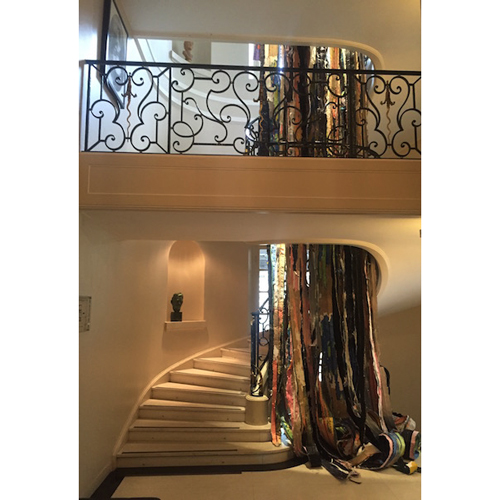 |
| Installation view of Mark Bradford's A Private Stranger Thinking About His Needs (2016). Photo: Courtesy the Artist and Hauser & Wirth via artnet.com. |
Curated by Shamim Momin
Featuring Edgar Arceneaux | Lisa Anne Auerbach | Math Bass | Mark Bradford | Sam Falls | Daniel Joseph Martinez | Jonathan Pylypchuk | Fay Ray | Ry Rocklen | Amanda Ross-Ho | Analia Saban | Shannon Ebner & Erika Vogt | Brenna Youngblood
March 11 - July 17, 2016
MONA BISMARCK AMERICAN CENTER
34 Avenue de New York
Paris, France
March 12 - July 17, 2016
GALERIE THADDAEUS ROPAC
69, Avenue du Général Leclerc
Pantin, France
From nomadicdivision.org:
Wasteland is a group exhibition curated by LAND (Los Angeles Nomadic Division)’s Director and Curator, Shamim M. Momin, at two parallel venues in Paris: the Mona Bismarck American Center and Galerie Thaddaeus Ropac Paris Pantin. The exhibition will be on view from March 11 through July 17, 2016. Hours of viewing at the Mona Bismarck American Center are Wednesday through Sunday, 11am-7pm; Galerie Thaddaeus Ropac, Pantin are Tuesday through Saturday, 10am-7pm. Wasteland features many of the most exciting contemporary artists based in Los Angeles, including Edgar Arceneaux, Mark Bradford, and Brenna Youngblood. The artists will be present for press previews and opening receptions at both venues: Mona Bismarck American Center: March 11, 2016, 7-9pm; Galerie Thaddaeus Ropac Paris Pantin: March 13, 2016, 2-6pm. A roundtable discussion with the artists moderated by Momin will be held at the Mona Bismarck American Center on March 12, 2016 at 3pm.
This unprecedented collaboration between LAND, the Mona Bismarck American Center, and Galerie Thaddaeus Ropac presents a unique opportunity to expand the reach of each institution’s audience, particularly that of LAND with this ambitious exhibition being the organization’s first international endeavor. Furthering the dialogue between two of the most dynamic art cities in the world, LAND and its partners will present curated programming that will take place in both Paris and Los Angeles throughout the run of the exhibition. A full schedule of events will be announced in the coming weeks.
Drawing on T.S. Eliot’s seminal modernist poem, The Waste Land, as the thematic thread between the 14 participating artists, the exhibition presents a reflexive, complex, multi-dimensional conversation about the poetics of despair, the search for true connection, the tenuous state of morality, and the uncertainty, yet necessity, of the future. The original text was published in 1922, written at a moment of disturbing parallel to the present, one of great disillusionment with the state of the world politically (post WWI) and culturally (the modern urban landscape) and individually (the increasing loss of true communication, connection, and faith).
Beyond the literary referent, the title also evokes other definitions and connotations — whether the old chestnut (long disproven but still present) of Los Angeles as a “cultural wasteland,” or a more literal reading of the word applied to the physical geography of both the city and the natural landscape of Southern California. It additionally calls to mind resonant images of the post-apocalyptic, the post-human, the potential future, largely created through the image magic of Los Angeles’ greatest export, Hollywood.
Diverse in nature and practice, the artists in Wasteland, who are all connected to Los Angeles, work in many different media and modes of presentation — a kind of “expanded practice” in which all aspects of their oeuvre are considered equally important; a performance as much as a sculpture, an interactive installation as much as a painting, a music group as much as a photograph. In keeping with this approach, this exhibition is an opportunity to additionally consider site — both the specific venues, as well as the city of Paris itself — as part of the work presented. In every case, the artist will create a newly commissioned work or recombine works to create a conversation with and between the two venues, as well as the two cities.
Furthering the idea of Los Angeles of a wasteland, the exhibition highlights a number of techniques, materials, and themes, examples of which include Edgar Arceneaux’s sculptural labyrinth library of crystallized books and scrolls engaging notions of the trajectory of Art History and African American identity; Lisa Anne Auerbach’s pairings of her political and provocative knitted panels and matching garments; Mark Bradford’s cascading sculptural painting in the staircase at the Mona Bismarck American Center of shreds of paper strips caked with paint and other debris edited from another work, referencing Bradford’s material and artistic waste; and Jon Pylypchuk’s anthropomorphic and otherworldy sculptural figures made of castaway objects such as cigarettes and old tennis rackets.
A catalogue will be published on the occasion of the exhibition, with an overall thematic text by Shamim M. Momin. Los Angeles-based writers, art historians, editors, and curators have been selected to contribute one essay specific to each of the fourteen artists on view. The writers include Andrew Berardini, Carol Cheh, Trinie Dalton, Cesar Garcia, Suzanne Hudson, Laura Hyatt, Jamillah James, Kristina Kite, Sharon Mizota, Julian Myers,Claire Rifelj, and Kate Wolf.
No comments:
Post a Comment